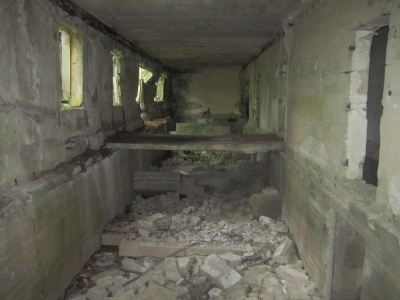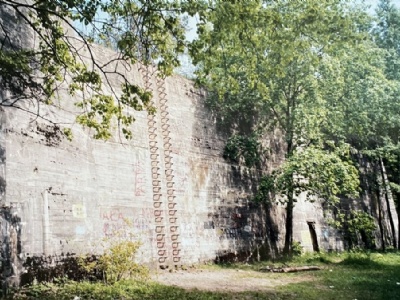Wolfsschanze
Just outside a small town called Ketrzyn (german Rastenburg) in northeastern Poland (then East Prussia) lied Hitler’s largest FHQ (Führerhauptquartier). Already in 1940 the German military command had reconnoitered and found a suitable place in the inhospitable Gierloz forest. The place consisted of marshland which served as a natural defense, but at the same time it brought huge mosquito problems for the German staff. Hitler arrived at Wolfschanze June 23, 1941, the day after Germany launched its attack on Soviet Union. He came to stay on and off for about 800 days for both shorter and longer periods. Wolfschanze was thus the FHQ that Hitler spent most time at during the war.
Wolfschanze was divided into three different security zones (Sperrkreis) where passports were required to enter each zone. Hitler’s bunker was in the innermost security zone. Wolfschanze underwent several expansions over the years and was still under expansion when Hitler left it for the last time in November 1944. Wolfschanze became a small town consisting of casinos, cinema, hair salon, guest hotel, private villas, railway station and a small airfield. At most, Wolfschanze consisted of about 80 bunkers and barracks and around 2000 people. General Alfred Jodl called Wolfschanze a mix between monastery and a concentration camp. On top of the bunkers, trees and other shrubs were planted to camouflage the site as much as possible from above. Even small roads that linked the bunkers and barracks were camouflaged from above. Hitler was concerned that the Soviet intelligence would find out where Wolfsschanze was located and therefore ordered that his own and other important bunkers be strengthened and security increased. Hitler’s personal bunker consisted of an eight-meter-thick concrete roof and six-meter-thick concrete walls to withstand any bombing at the time.
The OKH military leadership (Oberkommando des Heeres) had established its headquarters just under twenty kilometres northeast of Wolfsschanze in a forest called the Mauerwald. Even SS chief Himmler had set up headquarters just over ten kilometres east of Wolfsschanze. Several other political leaders also set up their headquarters nearby in order to be available at all times for deliberations. The reason why the military leadership and other political leaders did not place their headquarters in Hitler’s FHQ was for security reasons. If Wolfschanze (or other FHQ) were bombed and destroyed, the Germans would not risk that the military leadership and other political leaders would be knocked out. In January 1945, the Germans evacuated Wolfsschanze and the bunkers and barracks were blown up. Some bunkers such as Hitler’s could not be completely destroyed because of their enormous construction. In those cases, the Germans had to content themselves with destroying the interior in order to leave as little value as possible to the Red Army.
It was also in Wolfschanze that Colonel Claus Schenk Graf von Stauffenberg did an attempt on Hitler’s life when he placed a bomb, hidden in a briefcase, under a table during a military conference July 20, 1944. The bomb exploded, directly killing three officers, a stenographer later died of his injuries. Hitler miraculously survived and there has been speculation why he survived. Some argue that the conference at the last moment was moved from a thick concrete bunker to a smaller barrack whose walls which could not withstand the blast created by the explosion. Meaning the bomb had lesser effect on people than if it had exploded in a thick concrete bunker. Others claim that the bag with the bomb was moved from one side of the sturdy oak table leg to the other side, away from Hitler. Meaning that the table leg actually had a protective effect as Hitler stood on the other side of the table leg. Further theories are the fact that Stauffenberg only managed to mount one of the two bombs he had in his briefcase. Meaning that the blast was heavily reduced and thus safed Hitler’s life. But it could also be pure luck that made Hitler survive. Whatever it may be, Hitler survived and became even more convinced of the myth that he was sent by providence to save Germany. His grip on Germany became stronger and was maintained with even more draconian methods after the attempt on his life.
Current status: Partly preserved/demolished with museum (1998).
Location: 54°04'49.43" N 21°29'41.15" E
Get there: Car.
Follow up in books: Seidler, Franz W. & Zeigert, Dieter: Hitler’s secret headquarters (2004).


















Wolfschanze is more like a popular tourist attraction than it is a museum. But Hitler sells and if you can ignore the commercialism that exists on the site, Wolfschanze is well worth a visit, after all, it is the place where Hitler spent most of the war and the place where the attempt of his life was carried out. Most bunkers and barracks remain, including Hitler’s, the interiors are destroyed but otherwise they remain. Although it is forbidden to enter the ruins this is ignored by everyone. But beware, rebar, cracks and large holes between floors are everywhere and are not always easy to detect, especially where the light is limited. I highly recommend to spend a full day att Wolfsschanze, not only the ruins close to Hitler’s bunker, but also the ruins scattered around the whole area.